Transforming Waste into Sustainable Construction Materials: Resistant Geopolymers from Recycled Sources
Abstract
1. Introduction
2. Results and Discussions
2.1. Chemical Resistance Tests
2.2. Characterizations
3. Materials and Methods
3.1. Materials
3.2. Preparation of Sodium Silicate from Glass Waste
3.3. Sodium Silicate Solution Titration
3.4. Geopolymer Samples Preparation
3.5. Chemical Resistance Tests
- tap water, with pH = 8.12 ± 0.01 and Λ = (0.6 ± 0.1) mS cm−1
- 0.1 M HCl solution, with pH = 1.03 ± 0.05 and Λ = (42.6 ± 0.1) mS cm−1
- 0.1 M NaOH solution, with pH = 13.11 ± 0.07 and Λ = (23.3 ± 0.1) mS cm−1
3.6. Characterizations
4. Conclusions
- Construction in contaminated soils: Geopolymers can be used for foundations or underground structures in soils with high acidity or alkalinity, preventing structural damage.
- Industrial flooring: Geopolymers can withstand exposure to chemical spills and harsh cleaning agents in factories and warehouses.
- Mechanical properties: Comprehensive evaluation of compressive strength, flexural strength, and toughness to ensure structural integrity.
- Optimization of formulations: Further research into the ideal ratios of waste materials and activators to maximize performance and consistency.
- Durability studies: Long-term assessment of resistance to freeze-thaw cycles, abrasion, and UV exposure.
- Scale-up and production: Developing cost-effective methods for large-scale production of geopolymers from waste materials.
- Life Cycle Assessment (LCA): A detailed LCA to fully quantify the environmental benefits compared to traditional cement, including energy consumption and CO2 emissions.
Supplementary Materials
Author Contributions
Funding
Data Availability Statement
Acknowledgments
Conflicts of Interest
Abbreviations
| C&D | Construction and demolition |
| C | Concrete waste |
| B | Hollow clay brick waste |
| SG | Glass waste-derived sodium silicate |
| PMMA | Poly(methyl methacrylate) |
| ATR-FTIR | Attenuated Total Reflectance—Fourier Transform Infrared Spectroscopy |
| XRD | X-Ray Diffraction |
| SEM-EDX | Scanning Electron Microscopy—Energy Dispersive X-Ray Spectroscopy |
References
- Giacobello, F.; Ielo, I.; Belhamdi, H.; Plutino, M.R. Geopolymers and Functionalization Strategies for the Development of Sustainable Materials in Construction Industry and Cultural Heritage Applications: A Review. Materials 2022, 15, 1725. [Google Scholar] [CrossRef]
- Amran, Y.H.M.; Alyousef, R.; Alabduljabbar, H.; El-Zeadani, M. Clean production and properties of geopolymer concrete; A review. J. Clean. Prod. 2020, 251, 119679. [Google Scholar] [CrossRef]
- Bakri, M.M.A.; Mohammed, H.; Kamarudin, H.; Niza, I.K.; Zarina, Y. Review on fly ash-based geopolymer concrete without Portland Cement. J. Eng. Technol. Res. 2011, 3, 1–4. [Google Scholar]
- Lancellotti, I.; Piccolo, F.; Traven, K.; Češnovar, M.; Ducman, V.; Leonelli, C. Alkali Activation of Metallurgical Slags: Reactivity, Chemical Behavior, and Environmental Assessment. Materials 2021, 14, 639. [Google Scholar] [CrossRef]
- Lancellotti, I.; Vezzali, V.; Barbieri, L.; Leonelli, C.; Grillenzoni, A. Construction and Demolition Waste (CDW) valorization in alkali activated bricks. In Wastes: Solutions, Treatments and Opportunities III; CRC Press: Boca Raton, FL, USA, 2019; ISBN 978-0-429-28979-8. [Google Scholar]
- Tchakouté, H.K.; Rüscher, C.H.; Kong, S.; Kamseu, E.; Leonelli, C. Geopolymer binders from metakaolin using sodium waterglass from waste glass and rice husk ash as alternative activators: A comparative study. Constr. Build. Mater. 2016, 114, 276–289. [Google Scholar] [CrossRef]
- Rahimpour, H.; Amini, A.B.; Sharifi, F.; Fahmi, A.; Zinatloo-Ajabshir, S. Facile fabrication of next-generation sustainable brick and mortar through geopolymerization of construction debris. Sci. Rep. 2024, 14, 10914. [Google Scholar] [CrossRef]
- Ye, T.; Xiao, J.; Duan, Z.; Li, S. Geopolymers made of recycled brick and concrete powder—A critical review. Constr. Build. Mater. 2022, 330, 127232. [Google Scholar] [CrossRef]
- Davidovits, J. Chemistry of geopolymeric systems, terminology. In 99 Geopolymer International Conference Proceedings; Geopolymer Institute: Saint-Quentin, France, 1999; Volume 2, pp. 9–40. [Google Scholar]
- Moudio, A.M.N.; Tchakouté, H.K.; Ngnintedem, D.L.V.; Andreola, F.; Kamseu, E.; Nanseu-Njiki, C.P.; Leonelli, C.; Rüscher, C.H. Influence of the synthetic calcium aluminate hydrate and the mixture of calcium aluminate and silicate hydrates on the compressive strengths and the microstructure of metakaolin-based geopolymer cements. Mater. Chem. Phys. 2021, 264, 124459. [Google Scholar] [CrossRef]
- Ahmari, S.; Zhang, L. Durability and leaching behavior of mine tailings-based geopolymer bricks. Constr. Build. Mater. 2013, 44, 743–750. [Google Scholar] [CrossRef]
- Ariffin, M.A.M.; Bhutta, M.A.R.; Hussin, M.W.; Mohd Tahir, M.; Aziah, N. Sulfuric acid resistance of blended ash geopolymer concrete. Constr. Build. Mater. 2013, 43, 80–86. [Google Scholar] [CrossRef]
- Amran, M.; Huang, S.-S.; Debbarma, S.; Rashid, R.S.M. Fire resistance of geopolymer concrete: A critical review. Constr. Build. Mater. 2022, 324, 126722. [Google Scholar] [CrossRef]
- Li, Q.-H.; Zhao, S.-Y.; Huang, B.-T.; Xu, L.-Y.; Xu, S.-L. Simultaneous enhancement of ductility and sustainability of high-strength Strain-Hardening Cementitious Composites (SHCC) using recycled fine aggregates. J. Clean. Prod. 2024, 470, 143357. [Google Scholar] [CrossRef]
- El-Seidy, E.; Chougan, M.; Al-Noaimat, Y.A.; Al-Kheetan, M.J.; Ghaffar, S.H. The impact of waste brick and geo-cement aggregates as sand replacement on the mechanical and durability properties of alkali–activated mortar composites. Results Eng. 2024, 21, 101797. [Google Scholar] [CrossRef]
- Bueno, E.T.; Paris, J.M.; Clavier, K.A.; Spreadbury, C.; Ferraro, C.C.; Townsend, T.G. A review of ground waste glass as a supplementary cementitious material: A focus on alkali-silica reaction. J. Clean. Prod. 2020, 257, 120180. [Google Scholar] [CrossRef]
- Altimari, F.; Lancellotti, I.; Leonelli, C.; Andreola, F.; Elsayed, H.; Bernardo, E.; Barbieri, L. Green materials for construction industry from Italian volcanic quarry scraps. Mater. Lett. 2023, 333, 133615. [Google Scholar] [CrossRef]
- Duxson, P.; Fernández-Jiménez, A.; Provis, J.L.; Lukey, G.C.; Palomo, A.; van Deventer, J.S.J. Geopolymer technology: The current state of the art. J. Mater. Sci. 2007, 42, 2917–2933. [Google Scholar] [CrossRef]
- Springer Nature. Alkali Activated Materials: State-of-the-Art Report, RILEM TC 224-AAM; Provis, J.L., Van Deventer, J.S.J., Eds.; RILEM State-of-the-Art Reports; Springer: Dordrecht, The Netherlands, 2014; Volume 13, ISBN 978-94-007-7671-5. [Google Scholar]
- García-Lodeiro, I.; Fernández-Jiménez, A.; Palomo, A. 17-Alkali-activated based concrete. In Eco-Efficient Concrete; Pacheco-Torgal, F., Jalali, S., Labrincha, J., John, V.M., Eds.; Woodhead Publishing Series in Civil and Structural Engineering; Woodhead Publishing: Sawston, Cambridge, 2013; pp. 439–487. ISBN 978-0-85709-424-7. [Google Scholar]
- Bakharev, T.; Sanjayan, J.G.; Cheng, Y.-B. Resistance of alkali-activated slag concrete to acid attack. Cem. Concr. Res. 2003, 33, 1607–1611. [Google Scholar] [CrossRef]
- Nath, S.K.; Kumar, S. Influence of iron making slags on strength and microstructure of fly ash geopolymer. Constr. Build. Mater. 2013, 38, 924–930. [Google Scholar] [CrossRef]
- Giannetto, A.; Puntoriero, F.; Notti, A.; Parisi, M.F.; Ielo, I.; Nastasi, F.; Bruno, G.; Campagna, S.; Lanza, S. Self-assembly of hexameric macrocycles from PtII/ferrocene dimetallic subunits—Synthesis, characterization, chemical reactivity, and oxidation behavior. Eur. J. Inorg. Chem. 2015, 2015, 5730–5742. [Google Scholar] [CrossRef]
- Chukanov, N.V.; Chervonnyi, A.D. Infrared Spectroscopy of Minerals and Related Compounds; Springer: Berlin/Heidelberg, Germany, 2016; ISBN 978-3-319-25349-7. [Google Scholar]
- Vafaei, M.; Allahverdi, A.; Dong, P.; Bassim, N. Acid attack on geopolymer cement mortar based on waste-glass powder and calcium aluminate cement at mild concentration. Constr. Build. Mater. 2018, 193, 363–372. [Google Scholar] [CrossRef]
- Part, W.K.; Ramli, M.; Cheah, C.B. An overview on the influence of various factors on the properties of geopolymer concrete derived from industrial by-products. Constr. Build. Mater. 2015, 77, 370–395. [Google Scholar] [CrossRef]
- Zhang, M.; Zhao, M.; Zhang, G.; Mann, D.; Lumsden, K.; Tao, M. Durability of red mud-fly ash based geopolymer and leaching behavior of heavy metals in sulfuric acid solutions and deionized water. Constr. Build. Mater. 2016, 124, 373–382. [Google Scholar] [CrossRef]
- Kogbara, R.B.; Al-Zubi, A.; Mortada, Y.; Hammoud, A.; Masad, E.A.; Khraisheh, M.K. Lime-activated one-part geopolymer mortars from construction, demolition and industrial wastes. Results Eng. 2024, 21, 101739. [Google Scholar] [CrossRef]
- Yang, H.; Li, C.; Wei, C.; Li, M.; Li, X.; Deng, Z.; Fan, G. Molybdenum blue photometry method for the determination of colloidal silica and soluble silica in leaching solution. Anal. Methods 2015, 7, 5462–5467. [Google Scholar] [CrossRef]
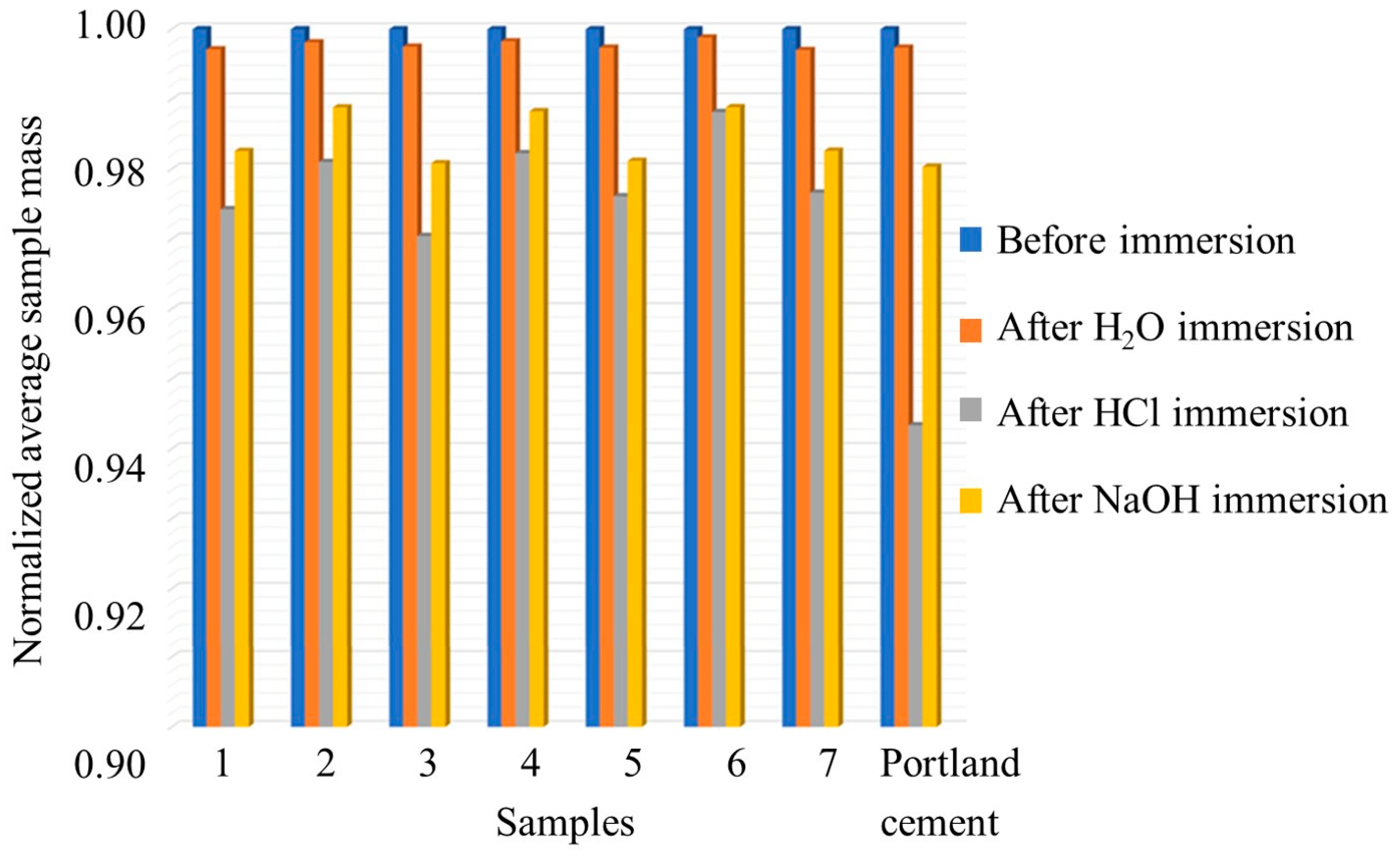


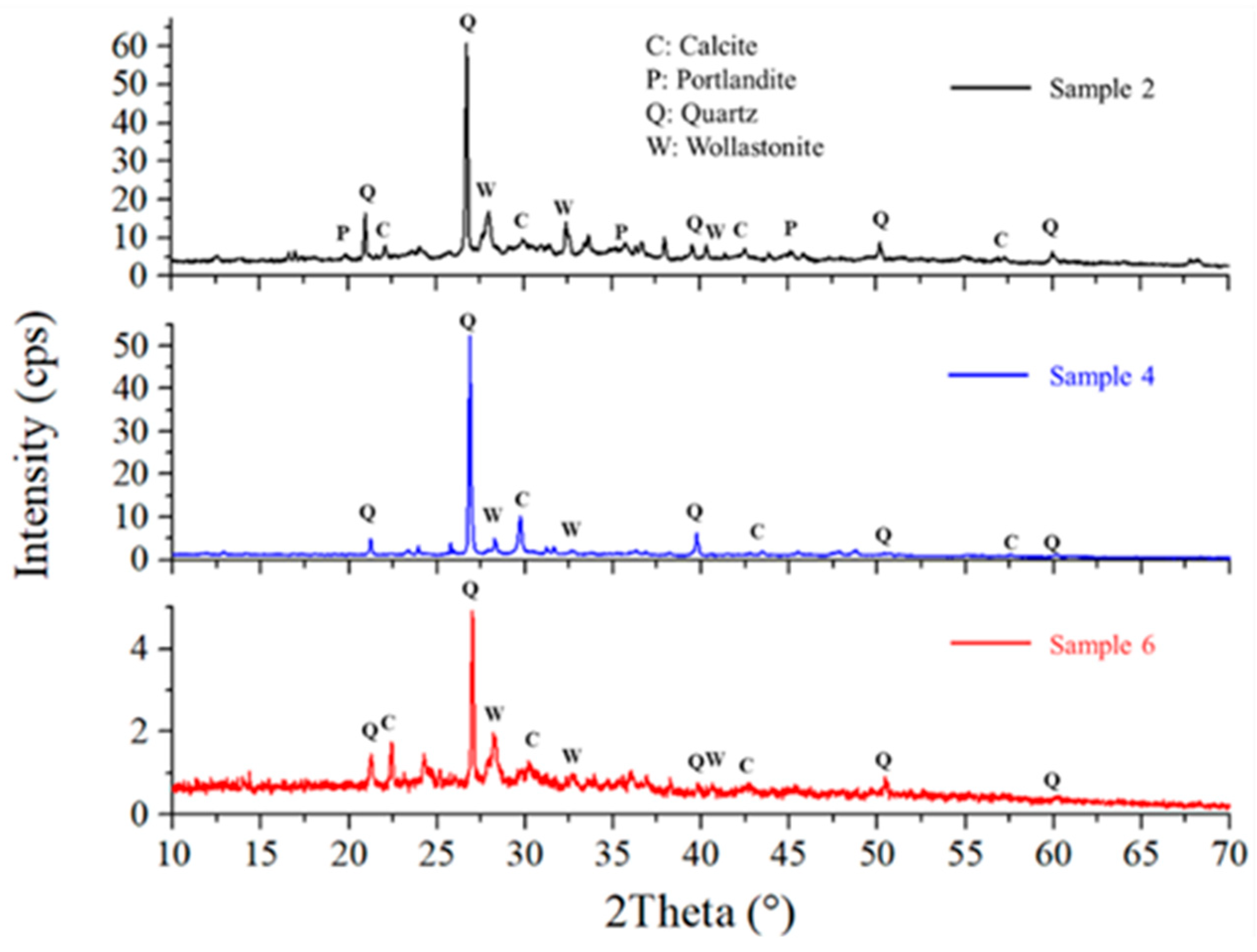
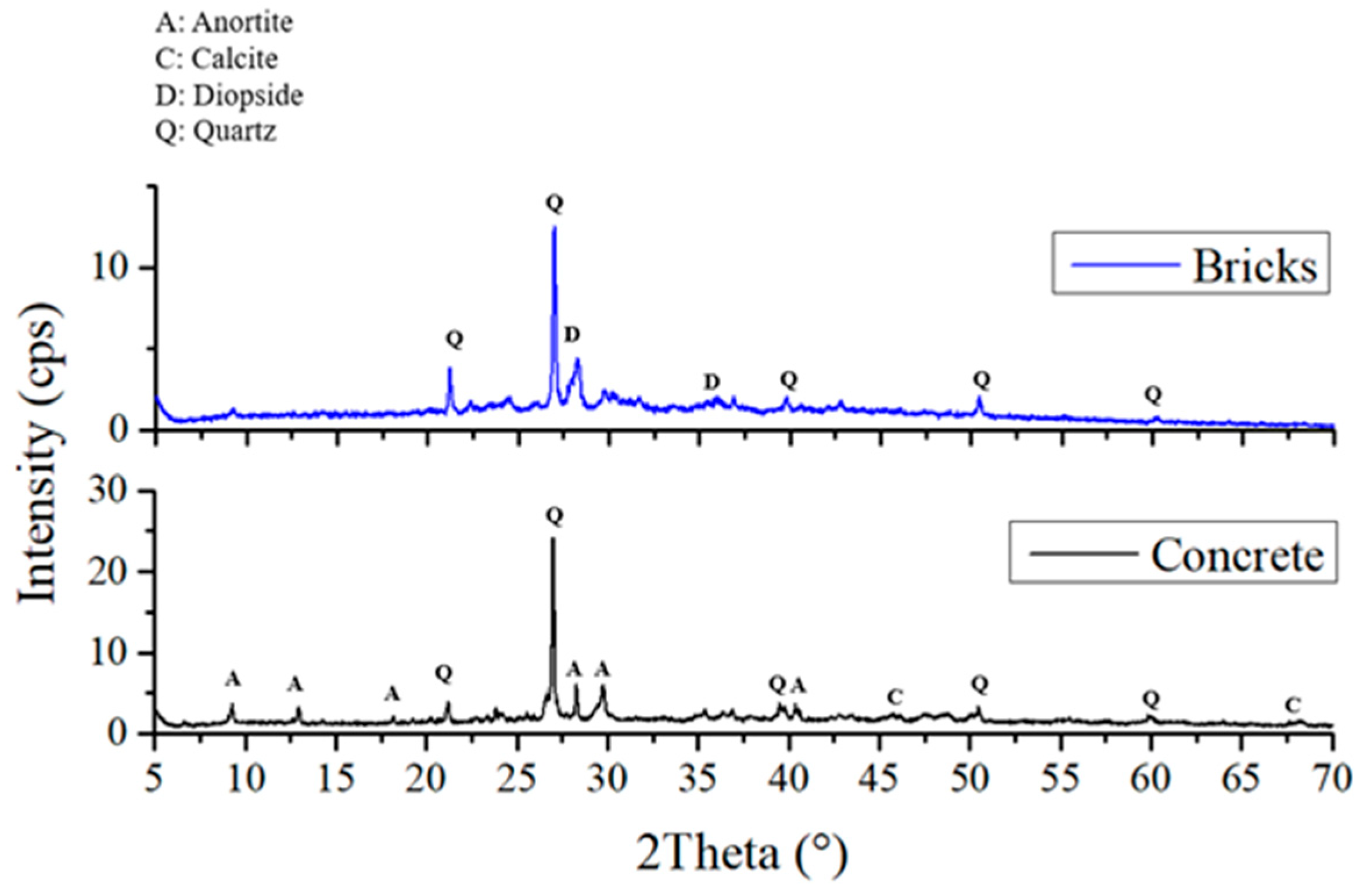


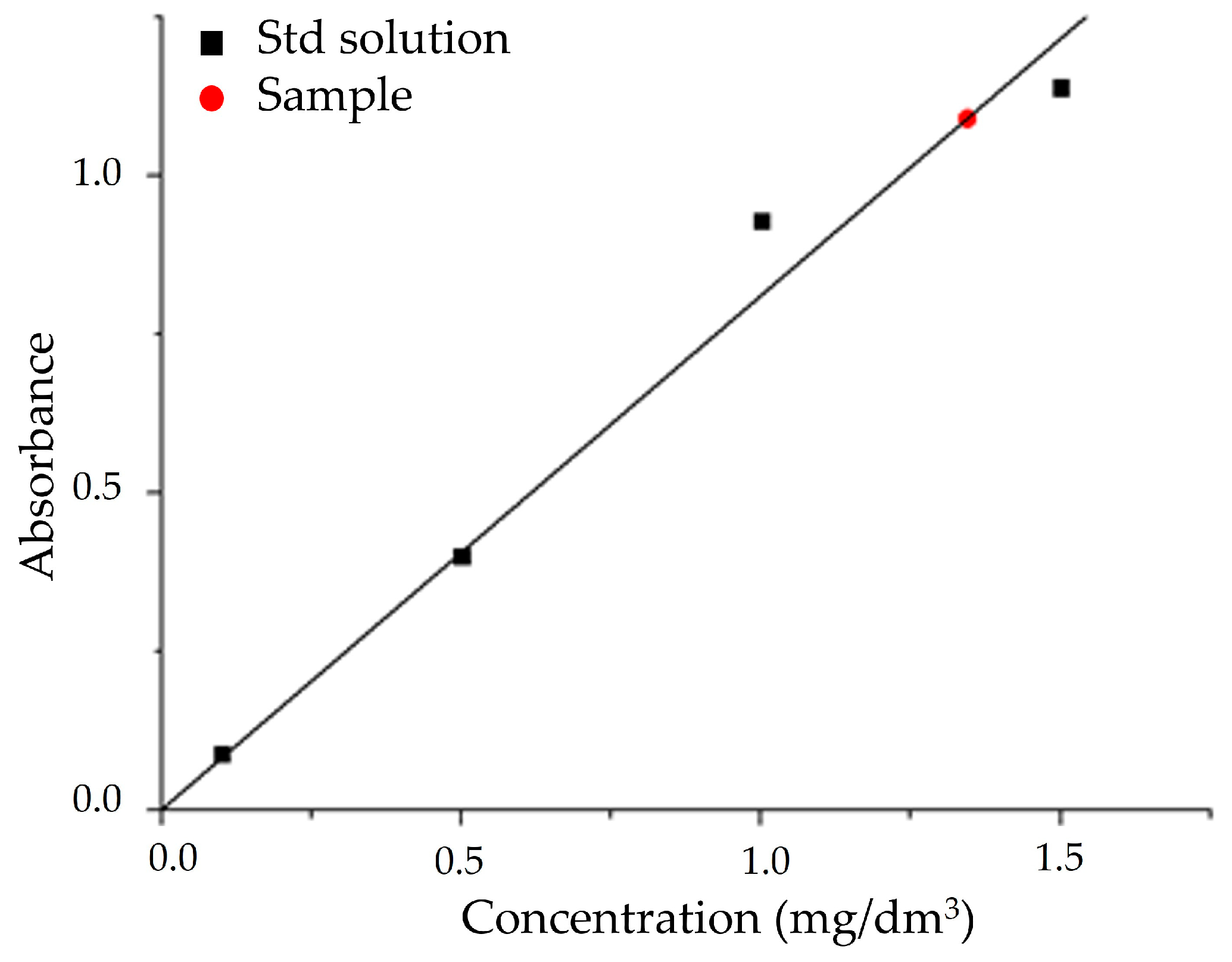
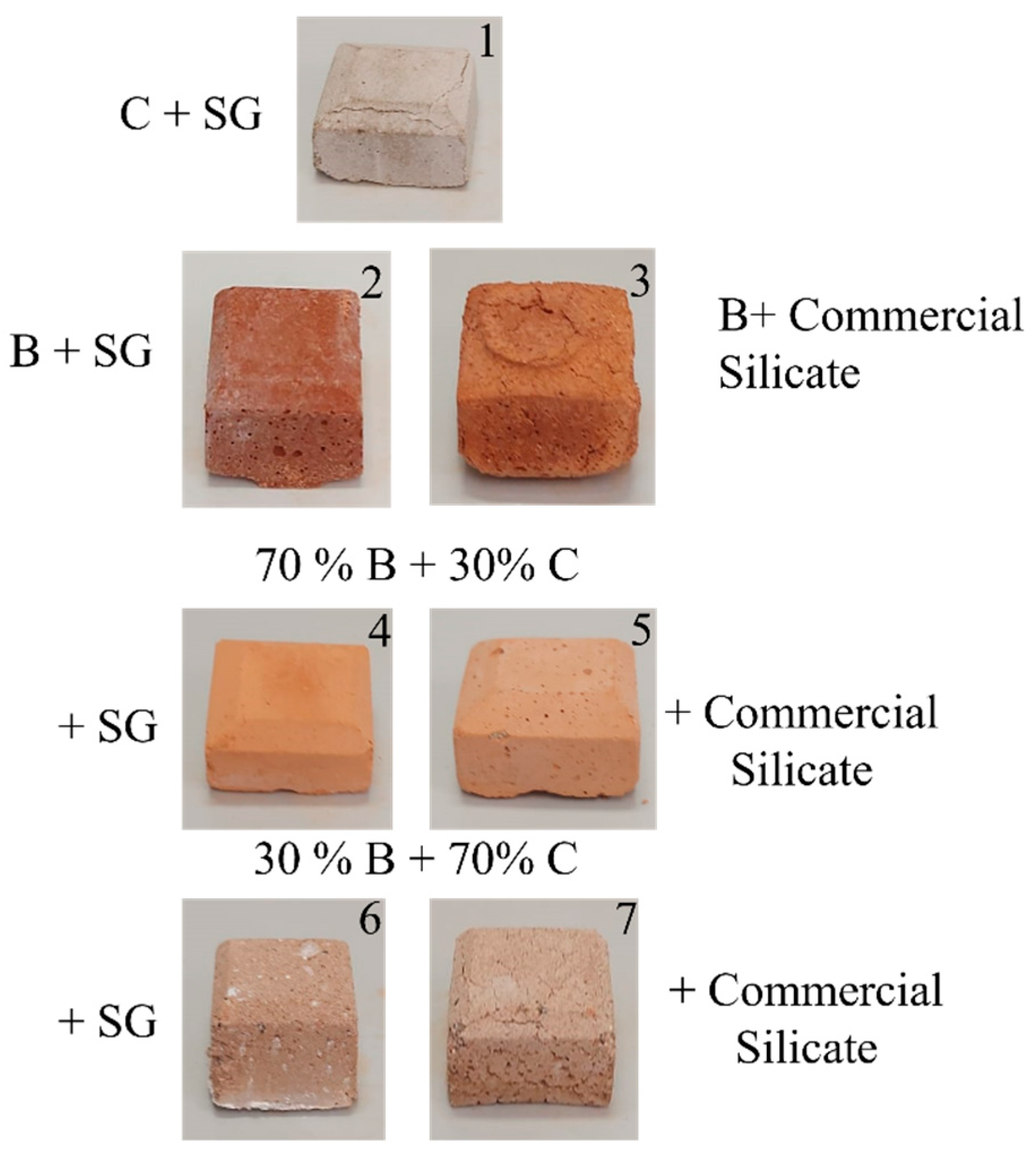
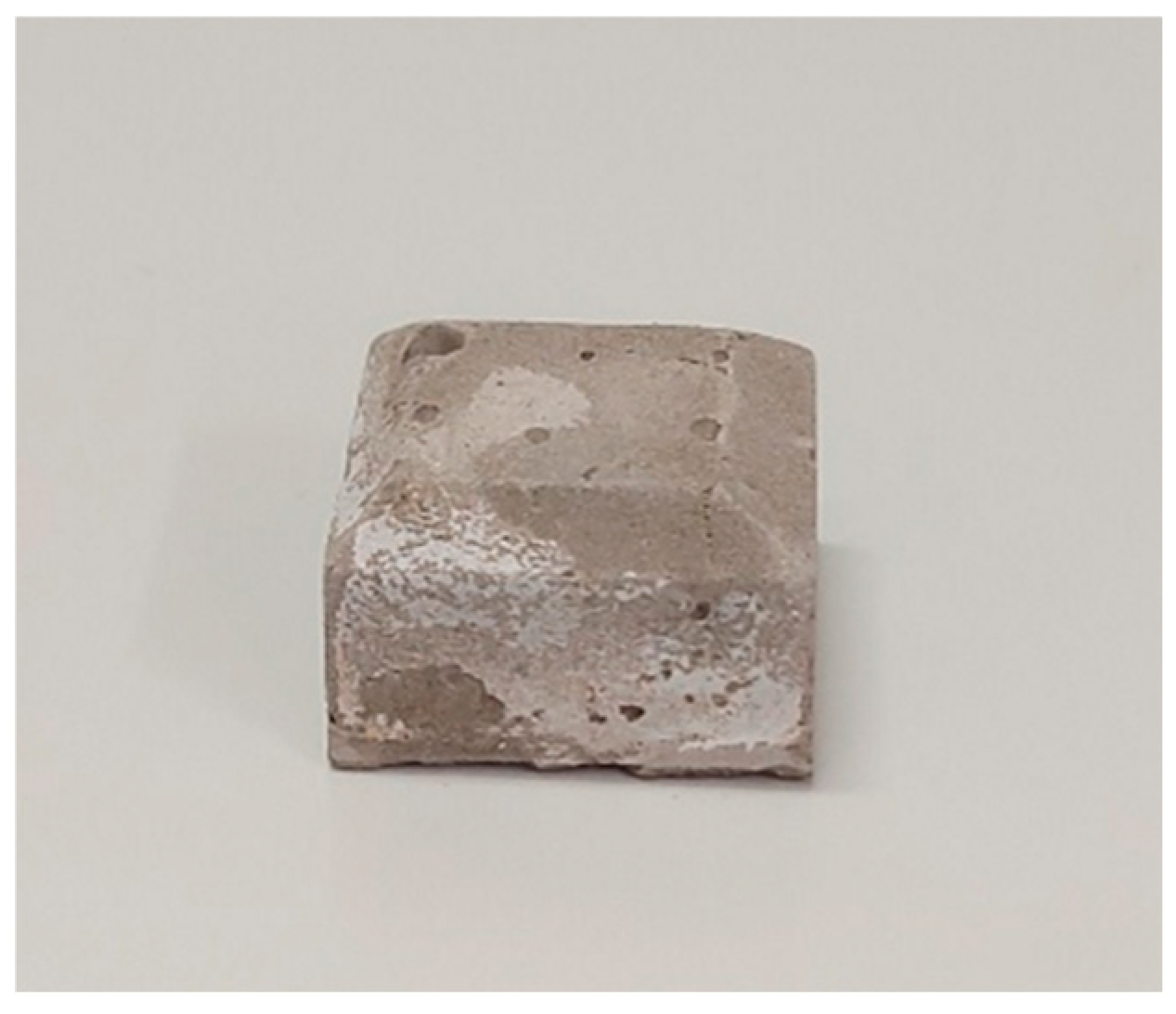
| Sample | % Weight Loss After 7-Day Immersion in | ||
|---|---|---|---|
| Tap Water | HCl (0.1 mol/dm3) | NaOH (0.1 mol/dm3) | |
| 1 | 0.29 ± 0.09 | 2.57 ± 0.02 | 1.74 ± 0.08 |
| 2 | 0.19 ± 0.08 | 1.90 ± 0.02 | 1.12 ± 0.07 |
| 3 | 0.25 ± 0.01 | 2.96 ± 0.01 | 1.92 ± 0.05 |
| 4 | 0.17 ± 0.06 | 1.77 ± 0.01 | 1.17 ± 0.06 |
| 5 | 0.26 ± 0.10 | 2.39 ± 0.02 | 1.88 ± 0.07 |
| 6 | 0.12 ± 0.07 | 1.18 ± 0.02 | 1.11 ± 0.05 |
| 7 | 0.30 ± 0.10 | 2.34 ± 0.01 | 1.74 ± 0.04 |
| Portland cement | 0.26 ± 0.05 | 5.66 ± 0.01 | 1.97 ± 0.08 |
| Sample | Si/Al | Si/Na | Si/Ca | Si/K | Si/Fe | Si/Mg |
|---|---|---|---|---|---|---|
| B | 2.48 ± 0.04 | 25.50 ± 0.15 | 2.48 ± 0.10 | 8.91 ± 0.16 | 4.45 ± 0.16 | 98.00 ± 0.52 |
| C | 1.41 ± 0.06 | 8.31 ± 0.35 | 1.71 ± 0.10 | 10.23 ± 0.27 | 5.54 ± 0.29 | 12.09 ± 0.13 |
| 2 | 1.94 ± 0.07 | 3.98 ± 0.08 | 3.63 ± 0.13 | 18.45 ± 0.66 | 8.12 ± 0.30 | 29.00 ± 0.17 |
| 4 | 1.75 ± 0.09 | 4.47 ± 0.11 | 1.34 ± 0.07 | 23.00 ± 0.60 | 9.47 ± 0.44 | 40.25 ± 0.28 |
| 6 | 1.81 ± 0.08 | 3.48 ± 0.08 | 3.13 ± 0.13 | 20.89 ± 0.47 | 7.23 ± 0.29 | 26.86 ± 0.17 |
| Sample | Band Position (cm−1) | ||
|---|---|---|---|
| 2 | 3160 | 1424 | 998 |
| 4 | 3240 | 1408 | 968 |
| 6 | 3204 | 1424 | 968 |
| Characteristic bands | O-H stretching | O-C-O stretching | Si-O-Si and Si-O-Al stretching |
| References | [25] | [11] | [26,27] |
| Symbol Element | B | C | 2 | 4 | 6 |
|---|---|---|---|---|---|
| O | 57.0 ± 0.8 | 63.0 ± 0.9 | 54.1 ± 0.9 | 56.4 ± 0.9 | 55.4 ± 0.9 |
| Si | 19.6 ± 0.4 | 13.3 ± 0.5 | 20.3 ± 0.5 | 16.1 ± 0.5 | 18.8 ± 0.5 |
| Al | 7.9 ± 0.2 | 9.4 ± 0.2 | 10.5 ± 0.5 | 9.2 ± 0.5 | 10.4 ± 0.6 |
| Na | 0.8 ± 0.1 | 1.6 ± 0.5 | 5.1 ± 0.3 | 3.6 ± 0.3 | 5.4 ± 0.3 |
| Ca | 7.9 ± 0.6 | 7.8 ± 0.5 | 5.6 ± 0.6 | 12.0 ± 0.5 | 6.0 ± 0.6 |
| K | 2.2 ± 0.3 | 1.3 ± 0.3 | 1.1 ± 0.7 | 0.7 ± 0.4 | 0.9 ± 0.4 |
| Fe | 4.4 ± 0.6 | 2.4 ± 0.6 | 2.5 ± 0.7 | 1.7 ± 0.7 | 2.6 ± 0.7 |
| Mg | 0.2 ± 0.1 | 1.1 ± 0.1 | 0.7 ± 0.1 | 0.4 ± 0.1 | 0.7 ± 0.1 |
| Sample | Mixture (w/w% ‖ kg/m3) | Commercial Sodium Silicate (w/w% ‖ kg/m3) | SG (w/w% ‖ kg/m3) | |
|---|---|---|---|---|
| C | B | |||
| 1 | 70 ‖ 1925 | - | - | 30 ‖ 825 |
| 2 | - | 70 ‖ 2052 | - | 30 ‖ 879 |
| 3 | - | 70 ‖ 2292 | 30 ‖ 982 | - |
| 4 | 50 ‖ 1475 | 20 ‖ 590 | - | 30 ‖ 885 |
| 5 | 50 ‖ 1530 | 20 ‖ 612 | 30 ‖ 859 | - |
| 6 | 20 ‖ 634 | 50 ‖ 1584 | - | 30 ‖ 950 |
| 7 | 20 ‖ 769 | 50 ‖ 1923 | 30 ‖ 1154 | - |
Disclaimer/Publisher’s Note: The statements, opinions and data contained in all publications are solely those of the individual author(s) and contributor(s) and not of MDPI and/or the editor(s). MDPI and/or the editor(s) disclaim responsibility for any injury to people or property resulting from any ideas, methods, instructions or products referred to in the content. |
© 2025 by the authors. Licensee MDPI, Basel, Switzerland. This article is an open access article distributed under the terms and conditions of the Creative Commons Attribution (CC BY) license (https://creativecommons.org/licenses/by/4.0/).
Share and Cite
Cigala, R.M.; Papanikolaou, G.; Lanzafame, P.; Sabatino, G.; Tripodo, A.; La Ganga, G.; Crea, F.; Ielo, I.; De Luca, G. Transforming Waste into Sustainable Construction Materials: Resistant Geopolymers from Recycled Sources. Recycling 2025, 10, 118. https://doi.org/10.3390/recycling10030118
Cigala RM, Papanikolaou G, Lanzafame P, Sabatino G, Tripodo A, La Ganga G, Crea F, Ielo I, De Luca G. Transforming Waste into Sustainable Construction Materials: Resistant Geopolymers from Recycled Sources. Recycling. 2025; 10(3):118. https://doi.org/10.3390/recycling10030118
Chicago/Turabian StyleCigala, Rosalia Maria, Georgia Papanikolaou, Paola Lanzafame, Giuseppe Sabatino, Alessandro Tripodo, Giuseppina La Ganga, Francesco Crea, Ileana Ielo, and Giovanna De Luca. 2025. "Transforming Waste into Sustainable Construction Materials: Resistant Geopolymers from Recycled Sources" Recycling 10, no. 3: 118. https://doi.org/10.3390/recycling10030118
APA StyleCigala, R. M., Papanikolaou, G., Lanzafame, P., Sabatino, G., Tripodo, A., La Ganga, G., Crea, F., Ielo, I., & De Luca, G. (2025). Transforming Waste into Sustainable Construction Materials: Resistant Geopolymers from Recycled Sources. Recycling, 10(3), 118. https://doi.org/10.3390/recycling10030118








